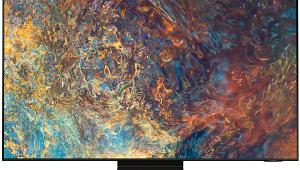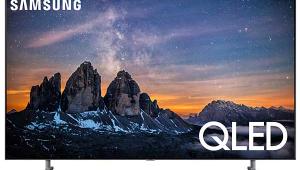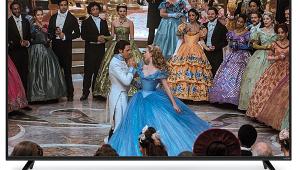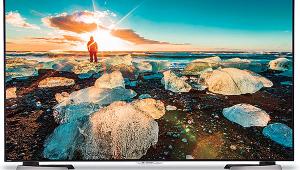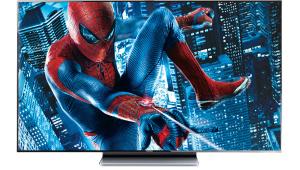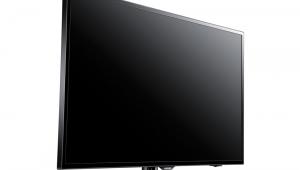Sony XBR-65X900A 3D LCD Ultra HDTV Page 2
2K Comparisons
For a side-by-side comparison, I fortunately had two first-tier 60-inch plasma sets in house: Samsung’s new PN60F8500 and a Pioneer Kuro PRO-141FD. The latter was the top model in Pioneer’s last generation of plasmas (2009), which many experts still consider the flat-screen HDTV to beat in some important respects, particularly black level.
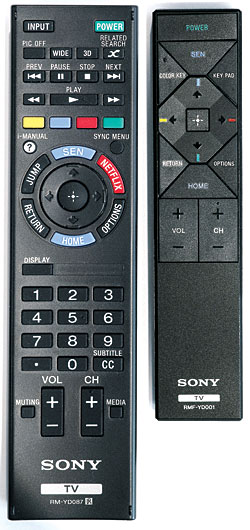 I’ve already noted a minor blue shift on the darkest scenes from the Sony. Two other viewers also commented that the Sony’s fleshtones had a hint of green in them, though I didn’t agree. The Pioneer has its own minor color issue, with a visible (though not always) light red tint on a totally black screen and in the black bars on widescreen movies. None of these deviations on either the Sony or Pioneer was serious, but the Samsung triggered no criticism of its color at all. For that reason alone it won the color faceoff by a nose.
I’ve already noted a minor blue shift on the darkest scenes from the Sony. Two other viewers also commented that the Sony’s fleshtones had a hint of green in them, though I didn’t agree. The Pioneer has its own minor color issue, with a visible (though not always) light red tint on a totally black screen and in the black bars on widescreen movies. None of these deviations on either the Sony or Pioneer was serious, but the Samsung triggered no criticism of its color at all. For that reason alone it won the color faceoff by a nose.
With the Sony’s upconversion of the source material to 4K, utilizing the set’s smaller pixels, you might expect it to score a walk-off home run in resolution. But it didn’t. On much of the material I watched, it was the softest looking of the three displays, even with optimum settings of its many resolution-altering controls (it has five, actually—Resolution in the Reality Creation menu, Sharpness, Detail and Edge Enhancer, and SBM—while the other two sets made do with a plain vanilla Sharpness adjustment). But softest does not mean soft. And the better the source resolution, the closer the three sets looked. The Avengers, the new Total Recall, and Battle: Los Angeles, for example (the latter two are from Sony’s new “Mastered in 4K” disc releases, mentioned earlier), were some of the sharpest transfers auditioned. They looked terrific on all three sets, and while the Sony never came out on top in the subjective resolution department (the Samsung did), its overall picture struck a pleasing balance of fine detail and creamy smoothness—a difficult combination to achieve.
Plasmas have a particular form of video noise called dithering, and when you’re very close to the screen, you can see it as a restlessness in the pixels—almost a squirming effect. Both the Samsung and the Pioneer had this (most obvious in the latter), and while it was invisible to me from several feet away on either set, some viewers are more sensitive to it. LCDs on the other hand, the Sony included, offer a “quiet” picture with no visible dithering at any viewing distance. Both plasma panels also generated a low-level buzz, but this was easily drowned out at any reasonable sound level. The Sony produced no odd noises.
Plasmas in general, and these two in particular, have no picture degradation off axis and no significant motion blur. LCDs, like the Sony, are less good in either regard. I found the XBR’s off-axis performance somewhat worse than on previous Sony sets, though at up to 20 degrees off axis (three viewers on a sofa about 8 to 10 feet away), most viewers won’t be bothered by the minor color fading and loss of contrast. But this worsens progressively at wider angles.
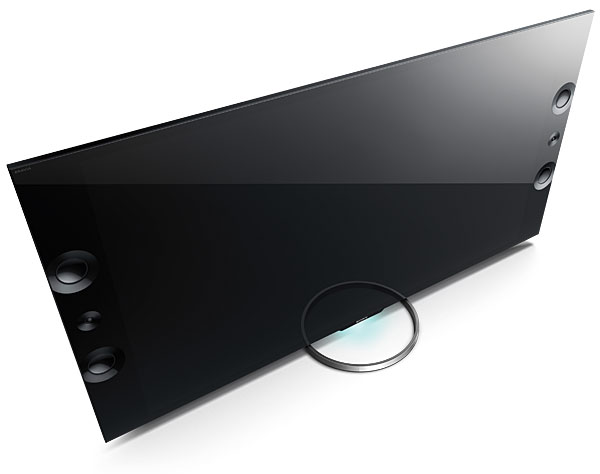
I wasn’t bothered by the Sony’s motion blur on most normal program material, even without Motionflow. I saw the blur clearly only on test scenes and patterns specifically designed to show it. But without frame interpolation, or brightness-robbing dark frame insertion, all LCDs produce at least subtle motion blur. This will inevitably reduce the resolution (and the benefits of 4K) on material with a lot of motion.
With the three sets adjusted for equal peak brightness on a window pattern, the Sony actually looked dimmer than the Samsung and the Pioneer on material of average brightness. But with the changes to the Sony’s settings discussed earlier, which made the Sony about 20 percent brighter on peak white than the plasmas, the three sets actually looked equally bright on most movie scenes. In this configuration, the Sony kept up with the other two sets nearly step for step in both black level and shadow detail. It was, for example, hard to fault in dark scenes from The Hobbit and The Avengers. Only on the most challenging material, such as the darkest scenes from Harry Potter and the Deathly Hallows: Part 2 or Prometheus, did the Pioneer significantly beat the other two sets. The Pioneer’s strength is that it never put a foot wrong on any dark, difficult material I used to challenge it. Keep in mind, however, that the Pioneer is the dimmest of the three sets and has no additional linear output available beyond what was needed for these tests. While its peak brightness was more than sufficient for a dark or dimly lit room, the Samsung had brightness in reserve, and the Sony was simply loafing.
4K and FauxK
By the time this review hits print, Sony should be offering an optional 4K server loaded with 10 movies. This server will be compatible only with Sony’s own 4K sets, and the initial content will be updatable for a charge when new movies become available. The company was not able to provide us with such a thoroughly loaded server for this review but did send along a small server designed for retail demonstrations. It had several short subjects, including a very short clip from the remake of Total Recall and the trailer for After Earth. All of this looked outstanding, even if some of the clips had outrageously over-the-top colors rarely seen in real life beyond trade shows.
Fortunately, the brief film clips were more realistic. I did compare the Total Recall clip with the same scene on the recently released “Mastered in 4K” Blu-ray version. Despite some matching and synchronizing issues that made the comparison less definitive than I would have liked, the two were very close. From a foot or two nearer to the screen than I prefer, I thought I saw additional detail in the native 4K version, particularly on small facial imperfections in close-ups, but this was very much a “now you see it, now you don’t” experience. The earth didn’t move under my feet as I switched back and forth—even here in California.
As noted earlier, Sony’s “Mastered in 4K” Blu-rays offer a route to using the new XBRs’ wider available range of color even on today’s 2K Blu-ray format. At first I thought these discs produced richer color, particularly reds. On The Other Guys, for example, a bright red Prius appeared unusually punchy and deeply saturated. But at most other times the color differences on these discs, compared with their bread-and-butter Blu-ray equivalents, were elusive. We’ll have more to say about these “Mastered in 4K” releases in the near future.
3D to Die For
The XBR-65X900A is the first Sony 3DTV designed for passive glasses. Four pairs are provided with the set; extras are $10 each. They’re light and comfortable, even when worn over prescription glasses.
When passive glasses are used for 3D in conventional HDTVs, the vertical resolution seen by each eye is reduced by half, to 1920 x 540. This is not HD, though in our experience it still looks sharp. In a 4K set, however, the resolution becomes 3840 x 1080 at each eye, and while this is no longer full 4K, it’s still clearly high definition. This enhanced vertical resolution also eliminates the black horizontal lines often visible with passive 3D on 2K sets.
The Sony’s 3D impressed me even more than its currently 4K-content-starved 2D. Its crisp detail, brilliant color, and more than satisfyingly bright images jumped off the screen. I measured a peak white output of 24 ft-L in its Cinema 1 3D mode. While the black levels weren’t quite as good as in 2D, they were still respectable. There was some 3D ghosting, but it was relatively rare and came and went so quickly, it was easy to ignore. Much of my 3D viewing was performed before the 3D calibration, and even then the extended sequences I watched from The Avengers, A Christmas Carol, Despicable Me, Wreck-It Ralph, Avatar, Life of Pi, Captain America, and Rise of the Guardians all drew me in. 3D fans who are on the fence (or skeptical) about the benefits of 4K, particularly on a less than Jumbotron-sized screen, simply must see a good demo of 3D on this set. Apart from the immersion possible from a theater-sized screen, I’ve never seen 3D in the theater (even IMAX 3D) that looked anywhere near this compelling.
Conclusions
I’ve been relatively picky about this new Sony, but make no mistake, it’s an excellent set. Apart from the lack of full LED backlit local dimming, which in our experience is superior to the edge-lit dimming offered here, this is arguably the best LCD HDTV of its size—Ultra HD or not—that Sony has yet produced.
Only with extended exposure to more 4K material than we have today, on sets of a size likely to show a significant benefit to 4K (I suspect this will be more than 65 inches), are we likely to know whether or not 4K is something we can’t live without. But despite this, and the XBR’s high sticker price, early adopters who want to bring home 4K, together with good black levels and shadow detail, brilliant but natural color, and state-of-the-art 3D, won’t be disappointed.
